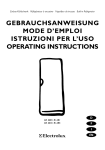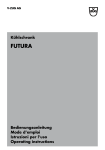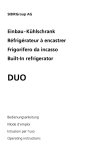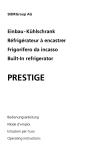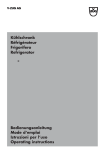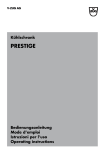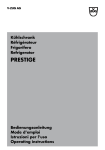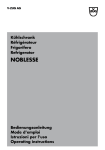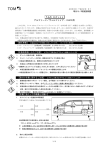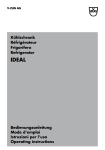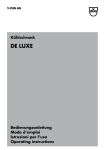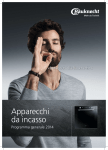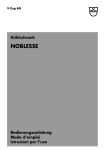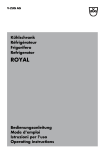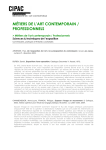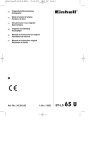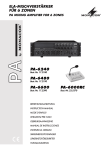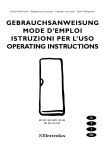Download gebrauchsanweisung mode d`emploi istruzioni per l`uso operating
Transcript
Einbau-Kühlschrank Réfrigérateur à encastrer Frigorifero da incasso Built-in Refrigerator GEBRAUCHSANWEISUNG MODE D’EMPLOI ISTRUZIONI PER L’USO OPERATING INSTRUCTIONS EK 276 / IK 275 EK 278 / IK 277 D F I EN Inhaltsverzeichnis Table des matières Bedienungsanleitungen Mode d’emploi 4 Einleitung 13 Introduction 4 Sicherheitshinweise und Warnungen 13 Instructions de sécurité et avertissements 5 Bedien- und Kontrollelemente 14 Elément de commande et de contrôlé 6 Einfrieren 15 Congélation 6 Innentür 15 Contre - porte 7 Abtauen 16 Dégivrage 8 Kühlraum 17 Compartiment réfrigérant 8 Reinigung 17 Nettoyage 8 Tipps 17 Conseils 9 LED ersetzen 19 Remplacement DEL 10 Störungen 19 Pannes 10 Garantie 19 Garantie 11 Betriebsgeräusche 20 Bruits de fonctionnement 12 Einbau / Masse 21 Encastrement / cotes 2 Sommario Contents Istruzioni per l’uso Operating instructions 22 Introduzione 31 Introduction 22 Norme di sicurezza e avvertenze 31 Safety information and warnings 23 Elementi di comando e di controllo 32 Operating and Control Panel 24 Congelamento 33 Freezing 24 Retroporta 33 Inner door 25 Scongelamento 34 Defrosting 26 Vano frigorifero 35 Refrigerator 26 Pulizia 35 Cleaning 26 Consigli 35 Tips 27 Sostituzione della lampadina 36 Replacing LED 28 Guasti 37 Malfunctions 28 Garanzia 37 Guarantee 29 Rumori di funzionamento 38 Operating noises 30 Installazione / dimensioni 39 Installation / dimensions 3 Sehr geehrte Kundin, sehr geehrter Kunde Sie sind im Besitze eines modernen und damit stromsparenden Kühlschrankes. Wir gratulieren Ihnen zu diesem Gerät! Das Gerät entspricht den anerkannten Regeln der Technik sowie der EG Richtlinie 73 / 23 / EWG (Niederspannungsrichtlinie) ist SEV geprüft nach EMV Richtlinie 89 / 336 / EWG und EN 55014.1993. Entsorgung des Altgerätes Ausgediente Geräte sofort unbrauchbar machen (z.B. Anschlusskabel abschneiden). Bitte achten Sie darauf, dass die Rohrleitungen Ihres Gerätes bis zum Abtransport zu einer sachgerechten, umweltfreundlichen Entsorgung nicht beschädigt werden. Für die Entsorgung der Altgeräte wenden Sie sich bitte an die zuständigen Stellen Ihrer Gemeinde. (Scharniere lösen und Tür entfernen, damit sich spielende Kinder nicht selbst einschliessen und in Lebensgefahr kommen.) Entsorgung der Verpackung ■ Dieses Gerät ist nicht zur Nutzung durch Personen mit verminderten körperlichen, sensorischen oder geistigen Fähigkeiten oder mangelnder Erfahrung und Kenntnis bestimmt, ausser wenn sie durch eine für ihre Sicherheit verantwortliche Person betreffend Gebrauch des Gerätes überwacht oder instruiert werden. Kinder sollten beaufsichtigt werden, um sicher zu stellen, dass sie nicht mit dem Gerät spielen. ■ Haben Sie ein beschädigtes Gerät erhal- ten, setzen Sie sich sofort mit Ihrem Lieferanten in Verbindung. ■ Verwenden Sie keine Verlängerungskabel. ■ Reparaturen und andere Eingriffe dürfen nur von einem Servicemonteur durchgeführt werden. ■ Beim Reinigen Stromzufuhr unterbre- chen: Stecker ausziehen oder Sicherung ausschalten. Ziehen Sie den Stecker nie am Kabel oder mit nassen Händen aus der Steckdose. Greifen Sie immer den Stecker und ziehen Sie ihn gerade aus der Steckdose. Alle verwendeten Verpackungsmaterialien sind umweltverträglich und wiederverwertbar. ■ Hochprozentigen Alkohol nur dicht ver- Sicherheitshinweise und Warnungen ■ Dieses Gerät ist FCKW- und FKW- frei Lesen Sie bitte vor Inbetriebnahme des Gerätes die in der Bedienungsanleitung aufgeführten Informationen sorgfältig durch und bewahren Sie diese für Nachbenützer auf. ■ Die elektrische Sicherheit (Berührungs- schutz) ist durch den Einbau sicherzustellen. ■ Benutzen Sie dieses Gerät nur für Haushaltzwecke und wie es in der Bedienungsanleitung beschrieben ist. 4 schlossen und stehend lagern, ausserdem keine explosiven Stoffe im Gerät lagern. Explosionsgefahr! und enthält das umweltverträgliche Kältemittel Isobutan (R600a) in geringen Mengen. ■ Bei der Handhabung des Gerätes muss darauf geachtet werden, dass der Kältekreislauf nicht beschädigt wird. Sollte der Kältekreislauf dennoch beschädigt werden, so sind offenes Feuer und Zündquellen jeder Art zu vermeiden. Der Raum in dem das Gerät steht, ist für einige Minuten zu lüften. ■ Ein Gerät mit beschädigtem Kreislauf darf nicht in Betrieb genommen werden. ■ Im eingebauten Zustand ist darauf zu achten, dass die Be- und Entlüftungsöffnungen nicht abgedeckt oder zugestellt sind. ■ Zur Beschleunigung der Abtauung dür- fen keine anderen mechanischen oder sonstige künstliche Mittel als die empfohlenen benutzt werden. % ■ Wird das Gerät zweckentfremdet, falsch bedient oder nicht fachgerecht repariert, kann keine Haftung für eventuelle Schäden übernommen werden. In diesem Fall entfallen Garantie oder weitere Haftungsansprüche. & ■ Wenn die Anschlussleitung dieses Gerä- tes beschädigt wird, muss sie durch den Hersteller oder seinen Kundendienst oder eine ähnlich qualifizierte Person ersetzt werden, um eine Gefährdung zu vermeiden. Keine elektrischen Geräte innerhalb des Lebensmittellagerraumes betreiben. +06 ■ Warnung: ; Bedien- und Kontrollelemente @ Haupttaste Ein / Aus: Ganzes Gerät: Ein / Aus. Kindersicherung: Taste muss mindestens 3. Sek. betätigt werden. = ; Temperaturanzeige: Es wird ein Temperaturmittelwert über die letzten 40 Minuten angezeigt. = Temperatureinstellung: @ Mittels zwei Tasten. +Taste wärmer, Taste kälter. Taste jeweils 3 Sek. betätigen. Normalstellung: 5 °C % Schnellkühltaste: Taste 3 Sekunden betätigen. Gerät kühlt während 36 Std. im Kühlraum auf 2 °C 5 und danach automatisch nach der eingestellten Temperatur. & Türoffenwarnung Kühlraum: Nach 2 Min. blinkt die LED im Abstand von 15 Sekunden. Rückstellung durch beliebige Taste. Nach 3 Min. blinkt die LED im Abstand von 5 Sekunden. Rückstellung durch beliebige Taste. Nach 4 Min. blinkt die LED rhythmisch im sekundentakt. Rückstellung durch beliebige Taste. Nach 10 Min.: akustischer Alarm. Rückstellung durch Taste Alarmquittierung. Dauer 3 Minuten, Wiederholung nach 30 Minuten Gefrierschale Mit der Beerenschale (Bild ;) können Sie Früchte (Beerenobst), Kräuter und Gemüse zum Garnieren schonend einfrieren. Das Einfriergut locker auf der Beerenschale verteilen. Achten Sie darauf, dass die Früchte nicht aneinander kleben. So bleiben diese weitgehendst in ihrer Form erhalten. Nach 10 bis 12 Stunden in Beutel oder Behälter umfüllen und in einer Gefriergutschale einlagern. Zum Auftauen das Gefriergut wieder locker nebeneinander ausbreiten. Einfrieren ■ Nur frische Lebensmittel sind für das Einfrieren geeignet. ■ Damit die Temperatur des bereits einge- lagerten Tiefkühlguts nicht zu stark ansteigt, nur kleine Mengen auf einmal einfrieren und die Schnellkühltaste betätigen (siehe Bedien- und Kontrollelemente). Es kann in allen Gefriergutschalen eingefroren werden. Die maximale Menge (8 kg) sollte in der obersten Gefriergutschale eingefroren werden. Zum Einfrieren der maximalen Menge muss die Schnellkühltaste 12 Stunden vor dem Einlegen des Tiefkühlguts betätigt werden. Temperatureinstellung in Normalstellung belassen, ca. 5 °C. Es ist vorteilhaft nur kleine Portionen abzupacken. ■ Einzufrierende Lebensmittel dürfen nicht mit bereits eingefrorenen in Berührung kommen. Aufgetautes Gefriergut darf nicht nochmals eingefroren werden, weil Lebensmittel verderben können. 6 ; Innentür Die Einhängeschalen (Bild =) in der Innentür sind leicht herausnehmbar und wieder einsetzbar: zuerst nach oben drücken und herausziehen und in umgekehrter Reihenfolge wieder einsetzen. Achtung: Verwenden Sie keine spitzen Gegenstände um Eis oder Festgefrorenes zu lösen. Gebrauchen Sie keine elektrischen Heizgeräte oder offene Flammen zum Abtauen. – Nach dem Abtauen Innenraum reinigen und gut trocknen. – Gerät am Haupttaster wieder einschalten = Abtauen Der Kühlraum taut vollautomatisch ab. Dabei wird das Eis, welches sich an der Rückwand bildet, geschmolzen (ca. 1 x pro Tag, siehe auch Tipps). Das Tauwasser fliesst durch das Ablaufloch (Bild %) aus und verdunstet in der Auffangschale ausserhalb des Gerätes. % Halten Sie den Sammelkanal und das Ablaufloch sauber, damit das Tauwasser ungehindert abfliessen kann. Ablaufloch mit dem darinbefindlichen grünen Reiniger säubern durch senkrechtes Bewegen und Drehen desselben. Das Gefrierabteil bei starker Eisbildung abtauen. Eine dicke Eisschicht verschlechtert die Kälteabgabe an das Gefriergut. Tiefkühlgut während der Abtauzeit möglichst kühl und gut isoliert lagern, z.B. in Zeitungen einpacken. – Gerät am Haupttaster auf «off» schalten. – Tauwasserablauf herausziehen (Bild &) – Wasserauffanggefäss unter Tauwasserablauf platzieren (Bild () – Tür offen lassen. & Das Abtauen kann wesentlich beschleunigt werden, wenn Sie ein Gefäss mit heissem Wasser in das Gefrierfach stellen. ( 7 Kühlraum Die bruchsicheren Glastablare sind individuell in der Höhe verstellbar. Die beiden Riegel seitlich ganz nach innen ziehen (Bild ) a) und zum Fixieren abwärts nach hinten drehen (Bild ) b). Das Glastablar aus der hinteren Führung ziehen und an gewünschter Position in umgekehrter Reihenfolge wieder einsetzen. Halbe Abstellflächen ermöglichen, dass hohe Gefässe stehend aufbewahrt werden können. )a )b 8 Reinigung Für die hygienische Aufbewahrung der Speisen den Innenraum möglichst sauber halten. Den Innenraum von Zeit zu Zeit mit einer milden Seifenlauge auswaschen und nachtrocknen. Ein gelegentliches Ausreiben mit Essigwasser wirkt geruchsbindend und ist zu empfehlen. Durch Sauberhalten der Türdichtungen kann ein Festkleben und damit deren Beschädigung vermieden werden. Keine scheuernden Reinigungsmittel oder kratzenden Lappen verwenden. Türdichtungen mit einer weichen Bürste oder einem Pinsel reinigen. Bei längerem Nichtgebrauch das Gerät am Haupttaster auf «off» schalten. Gerät ausräumen, abtauen, reinigen und Gerätetür sowie Gefrierabteiltür offen lassen. – Das Bedien- und Kontrollelement nur mit einem leicht angefeuchteten Lappen reinigen. – Darauf achten, dass möglichst kein Reinigungswasser durch die Ablauföffnung in die Verdunsterschale läuft. – Vor Inbetriebnahme müssen das Gerät und die Dichtungen von Gerätetür und Gefrierabteiltür vollkommen trocken sein. Tipps Bei der Benutzung des neuen Gerätes sind folgende Punkte zu beachten: ■ Das Gerät möglichst nicht in der Nähe von Heizkörpern, Heizrohren oder Rauchabzügen installieren und vor direkter Sonnenbestrahlung schützen. ■ Ein neu in Betrieb genommenes Gerät benötigt ca. 15 Std. (mit Lebensmittel) bis es die normalen Betriebstemperaturen erreicht hat. ■ Gerätetür möglichst kurzzeitig geöffnet halten. Bei Türöffnung über 2 Minuten beginnt die Beleuchtung zu blinken. Vergewissern Sie sich beim Schliessen, dass die Tür überall vollständig abdichtet. Die selbstschliessenden Scharniere unterstützen dies. ■ Die Abkühldauer von Getränken und anderen Lebensmittel von Raumtemperatur auf Kühlraumtemperatur kann bis zu 6 Stunden dauern. Je mehr warme Speisen eingelagert werden, um so mehr verlängert sich diese Dauer. ■ Verstellen der Temperatureinstellung hat keinen Einfluss auf die Abkühlgeschwindigkeit, sondern nur auf das Temperaturniveau. ■ Warmes oder gar heisses Lagergut ausserhalb des Gerätes abkühlen lassen. ■ Durch das Einlagern von feuchtigkeitsabgebender Lebensmittel kann es zu Kondensbildungen an den Glastablaren kommen. ■ Die elektronische Regelung taut den Kühlraum nur noch ungefähr einmal am Tag ab. Eine meistens sichtbare Eisbildung an der Rückwand im Kühlraum ist deshalb normal. ■ Achten Sie darauf, dass das Kühlgut nicht mit der Rückwand des Kühlraumes in Berührung kommt, damit es nicht anfriert und beim Abtauen das Wasser nicht in den Kühlraum abgeleitet wird. – Auf den Tablaren von oben nach unten Backwaren, fertige Speisen, Molkereiprodukte, Fleisch- und Wurstwaren. – In den Einhängeschalen von oben nach unten: Butter und Käse, Tuben, kleine Dosen und Eier, grosse Flaschen. – In der Gemüseschale Gemüse, Obst und Salate. LED Beleuchtung auswechseln Stromzufuhr unterbrechen: Stecker ausziehen oder Sicherung ausschalten. Klicken Sie die LED-Beleuchtung aus (Bild +). Lösen Sie die Steckverbindung zur LEDBeleuchtung (Bild §). Die neue LED-Beleuchtung bitte in umgekehrter Reihenfolge einsetzen. Hinweis: Verwenden Sie bitte nur original LED-Beleuchtungen vom Hersteller. ■ Beim Einordnen beachten: – Öl und Fett nicht mit den Kunststoffteilen und der Türdichtung in Berührung bringen. – Im Kühlraum befinden sich bei jeder Betriebsstellung der Temperatureinstellung die kältesten Bereiche an der Rückwand und über der untersten Ablage. Empfindliche Lebensmittel daher auf die unterste Ablage legen. + ■ Einordnungsbeispiel: – Im Gefrierabteil Lebensmittel einfrieren, lagern und Eis zubereiten. § 9 Störungen Das Gerät wurde vor der Auslieferung auf einwandfreie Funktion geprüft. Im Falle von Betriebsstörungen wenden Sie sich bitte an die nächstgelegene Servicestelle unter Angaben der Modellnummer sowie der festgestellten Mängel. Störungen können auch durch das Ansprechen elektrischer Sicherungen entstehen. Der Schaden ist leicht behoben, wenn Sie die entsprechende Sicherung wieder aktivieren. Fühlerfehlfunktionen: – Fehleranzeige F1 am Temperaturdisplay links = Temperatursensor am Kühlraum defekt – Fehleranzeige F7 am Temperaturdisplay rechts = Umgebungstemperatursensor defekt Garantie Wir gewähren die Garantie ab Lieferdatum des Gerätes an den Endverbraucher. Allfällige Mängel, die während dieser Zeit trotz vorschriftsmässigem Gebrauch auftreten und auf einen Material - oder Fabrikationsfehler zurückzuführen sind, werden im Rahmen dieser Garantie durch den Kundendienst behoben. Nicht unter Garantie fallen: – LED-Defekte – Bruch von Glasplatten und Kunststoffteilen – Defekte durch Nichtbefolgen der Bedienungsanleitung oder unsachgemässen Gebrauch – Schadenersatzansprüche, die über unsere Garantieleistungen hinausgehen – Geräte, welche durch Dritte repariert wurden. 10 Betriebsgeräusche Ganz normale Geräusche Das Kühlen wird durch einen Kompressor (Kälteaggregat) ermöglicht. Der Kompressor pumpt das Kältemittel durch das Kühlsystem. Dabei entstehen Betriebsgeräusche. Auch nach dem Ausschalten des Kompressors sind Geräusche durch Druckund Temperaturunterschiede unvermeidbar. Dieses Gerät ist nach dem neuesten Stand der Entwicklung, mit einem leisen Kompressor und einem geräuschoptimierten Kältekreis ausgestattet. Dennoch lassen sich bestimmte Geräusche nicht ganz vermeiden und sind in ihrer Lautstärke abhängig von der Gerätegrösse. Unmittelbar nach dem Einschalten des Kompressors sind die Betriebsgeräusche am besten hörbar. Sie werden mit fortschreitender Betriebsdauer leiser. Nicht normale Geräusche Meist entstehen ungewöhnliche Geräusche durch einen ungeeigneten Einbau. Das Gerät muss waagerecht und stabil aufgestellt bzw. eingebaut sein. Rohrleitungen dürfen auf keinen Fall an einer Wand oder anderen Möbeln anstehen. Auch dürfen die Rohrleitungen sich nicht gegenseitig berühren. In offenen Küchen oder bei in Raumteiler eingebauten Geräten werden die normalen Betriebsgeräusche intensiver wahrgenommen. Dies ist jedoch kein Mangel sondern bedingt durch die Architektur. Stichwort Ursache Bemerkung Brummen Kälteaggregat normales Arbeitsgeräusch des Kälteaggregates, Lautstärke abhängig von der Gerätegrösse Surren Ventilator normales Betriebsgeräusch, durch Belüftung Gurgeln Blubbern Rauschen Kältekreislauf normales Betriebgeräusch, durch Strömung des Kältemittels im Kältekreis Zischen Kältekreislauf normales Betriebsgeräusch durch Einspritzen des Kältemittels in den Verdampfer Klicken Thermostat normales Schaltgeräusch eines elektromechanischen Temperatur-Reglers oder Magnetventils Klappern Tablare, Körbe, Einhängeschalen Beladung etc. Innenteile so anordnen, dass sie sich nicht berühren bzw. dass sie fixiert sind. Knacken Gehäuse Normale, temperaturbedingte Spannungsdehnungen der Materialien z.B. Kunststoffe, Isolation 11 Einbaukühlschrank SMS 12/6 (1524 (1524mm) Nische SINK mm) Bei Nischentiefen 550 werden die Leistungsdaten des Gerätes ebenfalls garantiert Ist der Netzstecker nach dem Aufstellen des Gerätes nicht mehr zugänglich, so ist installationsseitig eine Trennvorrichtung vorzusehen. Als Trennvorrichtung gelten Schalter mit einer Kontaktöffnung von mindestens 3 mm, dazu gehören LS-Schalter und Sicherungen sowie Schütze. Lüftungsquerschnitt oben und unten min. 200 cm2 7/6-Spalt Türblätter CH min. 50 Detail A Dicke 16 – 20 mm 5/6-Spalt (420) 1850 SMS-Norm 1850 SINK-Norm 547 - 02 120 Dicke 16 – 24 mm max. 594 min. 50 Nische 560 – 568 105° 525 Apparat 548 Nische 550 555 Apparat 548 Nische 550 100° Nische 550 Apparat 545 A 602 200 Nische 605 Nische 605 430 Lüftung Apparat 548 100° 12 Integriert EU Apparat 545 Dekorrahmen Apparat 570 Integriert CH 635 100 635+Nischenüberstand unten -Spalt/2 889+ Nischenüberstand oben -Spalt/2 889 Nische 1524 Apparat 1522 Türblätter EU Chère Cliente, Cher Client, Vous possédez un réfrigérateur moderne, consommant donc peu de courant. Nous vous félicitons de votre achat! Cet appareil répond aux règles techniques reconnues de même qu’à la directive CE 73 / 23 / CEE (directive pour la basse tension). Il est homologué par l’ASE selon les directives de CEM (compatibilité électromagnétique) 89 / 336 / CEE et EN 55014. 1993. Elimination de l’ancien appareil Rendre immédiatement inutilisables les appareils usagés (p. ex. couper le cordon d’alimentation). Veillez, ce faisant, à ce que les conduites de votre appareil ne soient pas endommagées jusqu’à son transport en un lieu où il sera éliminé dans les règles conformes à la protection de l’environnement. A cet effet, adressez-vous au service compétent de votre commune. (Dégager les charnières et enlever les portes afin que des enfants en train de jouer ne s’enferment pas à l’intérieur mettant ainsi leur vie en danger). Elimination de l’emballage Tous les matériaux d’emballage employés sont compatibles avec l’environnement et recyclables. Instructions de sécurité et avertissements Avant de mettre l’appareil en service, nous vous prions de lire attentivement les instructions figurant dans le mode d’emploi et de conserver ce dernier pour un futur utilisateur éventuel de l’appareil. ■ Mettre en sûreté électrique (protection contre les contacts accidentels) en l’encastrant comme il faut. ■ N’utilisez cet appareil qu’à des usages domestiques et comme décrit dans le mode d’emploi. ■ Cet appareil n'est pas conçu pour être utilisé par les personnes aux capacités physiques, sensorielles ou intellectuelles réduites ou ne disposant pas d'expérience et de connaissances suffisantes, sauf si elles sont surveillées ou instruites par une personne responsable de leur sécurité quant à l'utilisation de l'appareil. Surveiller les enfants pour s'assurer qu'ils ne jouent pas avec l'appareil. ■ Si votre l'appareil vous a été livré endommagé, mettez - vous immédiatement en contact avec votre fournisseur. ■ Ne pas utiliser de rallonge. ■ Les réparations et autres interventions ne doivent être réalisées que par un dépanneur qualifié. ■ Pour le nettoyage, couper l’alimentation électrique: sortir la fiche ou déconnecter le fusible. Ne jamais tirer la fiche de la prise par le câble ou avec des mains mouillées. Toujours saisir la fiche et l’extraire droite de la prise. ■ Conserver les alcools concentrés uniquement fermés et placés debout. De plus, ne jamais ranger de matières explosives dans l’appareil. Risques d’explosion! ■ Cet appareil ne comporte pas de CFC et de FC. Il contient le réfrigérant écologique isobutane (R600a) en petites quantités. ■ Lors de la manipulation de l’appareil, toujours veiller à ce que le circuit réfrigérant ne soit pas endommagé. Si, cependant, le cas se présentait, éviter la présence de toute flamme vive ou sources d’étincelles. Aérer le local où se trouve l’appareil pendant quelques minutes. ■ Un appareil ayant un circuit réfrigérant endommagé ne doit pas être mis en service. 13 ■ En montage encastré, il faut veiller à ce que les orifices d’admission et de sortie d’air ne soient pas obstrués ou recouverts. ■ Pour accélérer le dégivrage, aucun moy- en mécanique ou artificiels autres que ceux recommandés ne doivent être employés. ■ Si l’appareil est utilisé à d’autres usages que ceux pour lesquels il a été prévu, manipulé ou réparé de manière impropre et incompétente, toute responsabilité sera déclinée en cas de dommages éventuels consécutifs. % & ■ Si le câble de raccordement de cet appa- reil est endommagé, il doit être remplacé par le fabricant ou son service après-vente, ou par un technicien qualifié, pour éviter tout danger. ■ Remarque importante: ne pas utiliser Eléments de commande et de contrôle ; +06 d’appareils électriques dans le compartiment destiné aux produits alimentaires. @ Touche principale En/Hors: Tout l'appareil: En/Hors. Sécurité enfants: la trouche doit être pressée pendant 3 secondes au moins. ; Indication de température: = Indication de la valeur moyenne de température des 40 dernières minutes. = Réglage de la température: Au moyen de deux touches: touche +, plus chaud, touche -, plus froid. Position normale: 5 °C % Touche refroidissement rapide: appuyer la touche 3 sec. L’appareil refroidit le compartiment supérieur à 2 °C pendant 36 h puis automatiquement é la température réglée. 14 @ & Touche d’acquittement alarme: Après 2 minutes, éclairage clignotant à l’intervalle de 15 sec., pour stopper appuyer un bouton quelconque. Après 3 minutes, éclairage clignotant à l’intervalle de 5 sec., pour stopper appuyer un bouton quelconque. Après 4 minutes, éclairage clignotant à l’intervalle d’1 sec., pour stopper appuyer un bouton quelconque. Après 10 minutes, alarme acoustique. pour stopper le signal acoustique appuyer le touche d’acquittement alarme. Durée 3 minutes, répétion après 30 minutes. Plateau de congélation Le plateau de congélation (figure ;), permet de conserver des fruits (baies), des herbes et des légumes pour les garnitures. Déposer sans serrer les produits sur le plateau de congélation. Veiller à ce que les fruits ne collent pas ensemble. Ils gardent ainsi largement leur forme. Après 10 à 12 heures, transvaser dans un sachet ou un récipient et déposer dans un bac de congélation. Pour dégeler, déposer de nouveau les produits les uns près des autres sans les serrer. Congélation ■ Seules des aliments fraîches conviennent à la congélation. ■ Pour éviter que la température des ali- ments déjà surgelés s’élève trop, ne congeler que de petites quantités à la fois et activer la touche refroidissement rapide (voir éléments de commande et de contrôle). Il est possible de congeler dans chacun des bacs. La quantité maximale (8 kg) devrait être congelée dans le bac supérieur. Pour congeler la quantité maximale, activer la touche refroidissement rapide 12 h avant de mettre les aliments à congeler. Laisser la température en position normale env. 5 °C. Il est préférable de n’emballer que par petites portions. ; Contre - porte Les balconets (figure =) de la contre - porte sont facilement amovibles et insérables: presser d’abord vers le haut et tirer, puis insérer dans l’ordre inverse. ■ Les aliments à congeler ne doivent pas entrer en contact avec celles déjà surgelées. Les produits alimentaires décongelés ne doivent pas être recongelés, car ils risquent de s’altérer. 15 de l’eau chaude dans le compartiment de congélation. Attention: ne jamais utiliser d’objets pointus pour détacher la glace ou les matières prises dans celle - ci. Ne pas employer d’appareils de chauffage électriques ou de flammes vives pour dégivrer. = – Après le dégivrage, nettoyer et bien sécher l’intérieur. – enclencher l’appareil au moyen de la touche principale. Dégivrage Le compartiment réfrigérant dégivre automatiquement. La glace qui se forme sur la paroi arrière est fondue (env. 1x par jour, voir aussi conseils). L’eau de dégivrage s’écoule alors par l’orifice d’évacuation (figure %) et s’évapore dans le bac placé à l’extérieur de l'appareil. Maintenir le canal collecteur et le trou d’évacuation bien propres de manière à ce que l’eau de dégivrage puisse s’écouler sans encombre. Nettoyer le trou d’évacuation avec le nettoyeur vert se trouvant dedans par des mouvements verticaux et rotatifs. Dégivrer le compartiment de congélation lorsqu’une épaisse couche de glace s’est formée. Cette couche entrave la congélation des aliments. Pendant le dégivrage, entreposer les produits surgelés dans un endroit aussi froid que possible en les isolant bien à l’aide, p. ex. de papier journal. % & – déclencher l’appareil au moyen de la touche principale. – Tirer le canal d'évacuation (figure &). – Placer un bac de récupération de l’eau de dégivrage sous le canal d’évacuation (figure (). – Laisser la porte ouverte. Le dégivrage peut être sensiblement accéléré en plaçant un récipient contenant 16 ( Compartiment réfrigérant Nettoyage Les étagères en verre incassable sont réglables individuellement en hauteur. Tirer les deux taquets à fond vers l’intérieur (fig. ) a) et pour fixer les tourner en bas vers l’arrière (fig. ) b). Tirer la plaque de verre du guidage arrière et la replacer en sens inverse à la position souhaitée. La surface de rangement subdivisée permet de conserver en position verticale des récipients de grande hauteur. L'appareil doit être maintenu bien propre pour une conservation hygiénique des aliments. Le nettoyer de temps en temps avec de l’eau savonneuse peu concentrée et le sécher. Il est recommandé de le frotter occasionnellement avec de l’eau vinaigrée pour enlever les odeurs. En nettoyant les joints de porte, on évite qu’ils se collent sur la carcasse et se détériorent en conséquence. Ne pas employer de détersifs abrasifs ou de chiffons rugueux susceptibles de provoquer des égratignures. Nettoyer les joints de porte à l’aide d’une brosse ou d’un pinceau souple. Si l'appareil n’est pas utilisé pendant une période prolongée, déclencher l’appareil au moyen de la touche principale. Le vider, dégivrer, nettoyer et laisser ouvertes les portes du compartiment réfrigérant et du compartiment congélateur. )a – Nettoyer les élements de commande et de contrôle seulement aven un chiffon humide. – Veiller, autant que possible, à ce que de l’eau de nettoyage ne s’écoule pas dans le bac collecteur par le trou d’évacuation. – Avant la mise en service, veiller à ce que l’appareil et les joints des portes du compartiment réfrigérant et du congélateur soient complètement secs. Conseils )b Tenir compte des points suivants lors de l’utilisation de votre nouvel appareil: ■ Installer l’appareil autant que possible loin de corps de chauffe, tuyaux de chauffage ou conduites de fumée et du rayonnement direct du soleil. ■ Un appareil nouvellement mis en service a besoin d’env. 15 heures (avec des aliments) pour atteindre les températures normales de service. 17 ■ Maintenir la porte de l'appareil ouverte ■ Lors du rangement, veiller à ce que: aussi brièvement que possible. Lors d’ouvertures dépassant 2 minutes, l’éclairage commence à clignoter. S’assurer en fermant que la porte soit partout bien hermétique. Les charnières autorabattantes assistent l’opération. ■ La durée de refroidissement des boissons et autres aliments depuis la température ambiante à celle de réfrigération peut demander jusqu’à 6 heures. Plus de aliments chaudes sont entreposées, plus cette durée se prolonge. ■ Le réglage du sélecteur de température n’a aucune influence sur la vitesse de refroidissement, mais uniquement sur le niveau de température. ■ Laisser reforidir les aliments chaudes ou même brûlantes à l’extérieur l'appareil. ■ Le stockage de marchandises dégageant de l’humidité peut entraîner la formation d’eau de condensation sur les étagères en verre. ■ La commande électronique ne dégivre le compartiment réfrigérant qu’environ une fois par jour. Souvent une couche de glace est visible sur la face arrière du compartiment réfrigérant – ceci est donc normal. ■ Veiller à ce que les aliments réfrigérées ne touchent pas la paroi arrière du compartiment réfrigérant de manière à ce qu’elles ne gèlent pas au contact celle-ci et que lors du dégivrage, l’eau ne soit pas dérivée dans le compartiment. – Les huiles et graisses n’entrent pas en contact avec les pièces en plastique et le joint de la porte. – Dans le compartiment réfrigérant, les zones les plus froides se trouvent, pour toutes les positions du sélecteur de température, près de la paroi arrière et au dessus de l’étagère en verre inférieure. En conséquence, mettre les aliments sensibles sur l’étagère inférieure. ■ Exemple de rangement: – Surgeler et entreposer les aliments alimentaires, préparer les glaçons dans le congélateur. – Placer sur les étagères de haut en bas, pâtisseries, repas préparés, produits laitiers, viandes et charcuterie. – Dans les balconets de haut en bas: beurre et fromages, tubes, petites boîtes et œufs, grandes bouteilles. – Dans les bacs à légumes: légumes, fruits et salades. 18 Changement de l’éclairage Pannes Couper l'alimentation électrique: sortir la fiche ou déconnecter le fusible. Le parfait fonctionnement de l'appareil a été vérifié avant sa livraison. En cas de panne, s’adresser au point de service le plus proche en indiquant le numéro de modèle et la défaillance constatée. Décliquer l’éclairage par DEL (figure +). Desserrer le cavalier de l’éclairage (figure §). Remettre le nouvel éclairage dans le sens contraire. Remarque: Utiliser uniquement des DEL d’origine! Des pannes peuvent également survenir à la suite de déclenchements de coupecircuits électriques. On remédie facilement au dommage en réactivant le coupe - circuit concerné. Défaut de fonction d’une sonde: – message d’erreur F1 à gauche de l’affichage = sonde temperature frigo défectueuse – message d’erreur F7 à droite de l’affichage = sonde temperature environnement défectueuse + Garantie Nous vous accordons la garantie à l’utilisateur dès la date de livraison de l’appareil. Toute défaillance survenant pendant cette période malgré une utilisation conforme aux instructions du mode d’emploi et due à un défaut de matériel ou de fabrication, sera réparée gratuitement dans le cadre de cette garantie par le service après - vente. § Ne sont pas couverts par la garantie: – DEL defectueux – bris de plaques en verre et de pièces en plastique – pannes dues à la non observation du mode d’emploi ou usage inapproprié – demandes de dédommagement dépassant nos prestations de garantie – appareils réparés par des tiers. 19 Bruits de fonctionnement Bruits tout à fait normaux C'est un compresseur (groupe frigorifique) qui permet la réfrigération. Le compresseur pompe le fluide réfrigérant et le fait passer dans le système de réfrigération. Cela provoque des bruits de fonctionnement. Même lorsque le compresseur est au repos, les bruits dus aux différences de pression et de température sont inévitables. Bruits anormaux Les bruits insolites tiennent la plupart du temps au fait que l'appareil n'est pas correctement installé. L'appareil doit être installé ou encastré sur une surface plane et être stable. Les tuyaux ne doivent en aucun cas toucher un mur ou d'autres meubles. Les tuyaux ne doivent pas non plus s’entretoucher. Cet appareil ultramoderne est équipé d'un compresseur silencieux et d'un circuit frigorifique dont le niveau sonore a été optimisé. Il est toutefois impossible d'éviter complètement certains bruits et leur volume sonore dépend de la taille de l'appareil. Dès que le compresseur se met en marche, c'est à ce moment-là que les bruits de fonctionnement sont le plus audibles. Ils diminuent d'intensité au fur et à mesure. On perçoit plus les bruits de fonctionnement normaux dans les cuisines ouvertes ou lorsque les appareils sont encastrés dans une séparation de pièce. Il ne s'agit pas là d'un défaut de l'appareil, mais d'un problème d'architecture. Bruit Cause Remarque Ronflement Groupe frigorifique Bruit normal du groupe frigorifique en marche, le volume dépend de la taille de l'appareil Ronronnement Ventilateur Bruit de fonctionnement normal dû à la ventilation Gargouillement Cycle frigorifique Glouglous Bruit de liquide Bruit de fonctionnement normal dû à la circulation du fluide réfrigérant dans le circuit frigorifique Sifflement Cycle frigorifique Bruit de fonctionnement normal dû à l'injection du fluide réfrigérant dans l'évaporateur Déclic Thermostat Bruit normal de mise en route du thermostat électromécanique ou d’une soupape magnétique Cliquetis Clayettes, bacs, balconnets, chargement, etc. Fixer les éléments intérieurs ou éviter qu'ils se touchent Craquement Habillage du réfrigérateur Tensions et allongements normaux des matériaux, p. ex., des matières plastiques, de l'isolation, dus à la température 20 Réfrigérateur à encastrer nische SMS12/6 12/6 (1524 (1524mm) niche SINK mm) Les caractéristiques de performance sont également assurées pour les niches de profondeur 550 Si la prise de courant n’est plus accessible après l’encastrement de l’appareil, il faut prévoir un organe de coupure sur l’installation. Comme organe de coupure sont admis les interrupteurs avec une distance de contacts d’au moins 3 mm, les fusibles, les disjoncteurs automatiques et les contacteurs. Section d’aération en haut et en bas min. 200 cm2 7/6-fente panneaux de porte CH min. 50 détail A épaisseur 16 – 20 mm 5/6-fente (420) SMS-Norm 18501850 SINK-Norm 547 - 02 120 épaisseur 16 – 24 mm max. 594 min. 50 A appareil 548 niche 550 niche 560 – 568 100° 105° 525 appareil 548 niche 550 555 appareil 548 100° appareil 545 niche 550 430 aération 602 200 niche 605 niche 605 intégré EU appareil 545 cadre décoratif appareil 570 intégré CH 635 100 635+dépassement de niche en bas -fente/2 889+dépassement de niche en haut -fente/2 889 niche 1524 appareil 1522 panneaux de porte EU 21 Stimata cliente, stimato cliente Lei è in possesso di un moderno frigorifero con basso consumo di elettricità. Ci congratuliamo con Lei per il suo acquisto! L'apparecchio è conforme alle regole riconosciute della tecnica nonché alla direttiva CE 73 / 23 / CEE (direttiva di bassa tensione) ed è omologato dall’ASE secondo la direttiva della CEM (compatibilità elettromagnetica) 89 / 336 / CEE e EN 55014.1993. Lo smaltimento di un vecchio apparecchio Gli apparecchi fuori uso devono essere immediatamente resi inutilizzabili (p.es. tagliare il cavo di alimentazione). Abbia cura che le tubazioni dell’impianto apparecchio non vengano danneggiate prima che l’apparecchio venga portato via per essere eliminato in maniera ecologica. Per l’eliminazione del suo vecchio apparecchio voglia rivolgersi all’ufficio competente del suo comune. (Mollare le cerniere e togliere le porte, in modo che i bambini che giocano non si chiudano dentro mettendo la loro vita in pericolo.) Eliminazione dell’imballaggio Tutti i materiali d’imballaggio utilizzati sono rispettosi dell’ambiente e riciclabili. Norme di sicurezza e avvertenze Prima di mettere in funzione l’apparecchio, leggete attentamente le istruzioni per l’uso e conservatele anche per gli altri utilizzatori. ■ La protezione contro le scariche elettriche deve essere assicurata dall’installatore. ■ Utilizzate questo apprecchio solo per uso domestico e come descritto nelle istruzioni. ■ Non è previsto l’uso del presente appa- recchio da parte di persone con ridotte capacità fisiche, sensoriali e intellettuali oppure con insufficienti conoscenze o 22 scarsa esperienza, a meno che queste persone non vengano sorvegliate o istruite da un responsabile per la loro sicurezza per quanto riguarda l’utilizzo dell’apparecchio. Prestare attenzione ai bambini per assicurare che non possano giocare con l’apparecchio. ■ Se l’apparecchio che avete ricevuto fosse difettoso, mettetevi immediatamente in contatto con il vostro fornitore. ■ Non utilizzate cavi di prolunga. ■ Riparazioni e altri interventi possono essere effettuati esclusivamente da un tecnico manutentore. ■ Per la pulizia togliete la corrente: staccate la spina e aprite l’interruttore automatico o togliete il fusibile. Non staccate mai la spina tirandola per il cavo né afferrandola con le mani bagnate. Afferrate sempre saldamente la spina e tiratela in fuori diritta dalla presa. ■ Conservate i liquidi ad alta gradazione alcolica solo in bottiglie ben chiuse e poste in piedi, inoltre non coservate nel frigorifero sostanze esplosive. Pericolo d’esplosione! ■ Questo frigorifero è privo di CFC e FC e contiene una quantità limitata del refrigerante isobutano (R600a), che non danneggia l’ambiente. ■ Nell’uso dell'apparecchio occorre prestare attenzione a non danneggiare il circuito refrigerante. Se dovesse però capitare un inconveniente del genere, evitate fiamme vive e fonti d’accensione di qualsiasi genere. Il locale in cui si trova l’apparecchio deve essere ventilato per alcuni minuti. ■ Non si deve assolutamente mettere in funzione un apparecchio il cui circuito refrigerante è danneggiato. ■ Se l’apparecchio è incassato, bisogna fare attenzione a non coprire né chiudere le aperture di entrata e di uscita dell’aria di ventilazione. ■ Per accelerare lo sbrinamento non si devono utilizzare mezzi meccanici o artificiali di qualsiasi genere, diversi da quelli consigliati. ■ Se l’apparecchio viene adibito a uno sco- po improprio, usato nel modo sbagliato o non è riparato a regola d’arte, si declina qualsiasi responsabilità per gli eventuali danni. In un caso del genere decadono la garanzia e qualsiasi pretesa di responsabilità. % & ■ Nel caso il cavo di collegamento di questo apparecchio dovesse essere danneggiato, deve essere sostituito dal fabbricante, o dal suo servizio assistenza clienti o da una persona adeguatamente qualificata, per evitare pericoli. +06 Non usare apparecchi elettrici all’interno del deposito di derrate alimentari. ; ■ Avvertimento. Elementi di comando e di controllo @ Interrutore generale Acceso / Spento: Intero apparecchio: Acceso / Spento. Sicura per bambini: Il tasto deve essere azionato per minimo 3 secondi. = ; Indicazione temperature: Indicazione del valore medio di temperatura degli ultimi 40 minuti. = Regolazione della temperatura: Mediante 2 tasti. Tasto + più caldo, tasto – più freddo. Posizione normale: 5 °C @ % Tasto raffreddamento veloce: Premere il tasto 3 sec. Il frigorifero viene raffreddato all’interno nel giro di 36 ore a 2 °C e in seguito automaticamente in base alla temperatura impostata. 23 & Allarme porta aperta della cella: Dopo 2 minuti: Lampeggio della lampadina con un intervallo di 15 secondi, disattivare il lampeggio premendo un tasto qualsiasi. Dopo 3 minuti: Lampeggio della lampadina con un intervallo di 5 secondi, disattivare il lampeggio premendo un tasto qualsiasi. Dopo 4 minuti: Lampeggio della lampadina con un intervallo di 1 secondo, disattivare il lampeggio premendo un tasto qualsiasi. Bacinella di congelamento Con la bacinella di congelamento (figura ;) potete congelare delicatamente frutti (bacche), erbe aromatiche e verdure per guarnizioni. Distribuite nella bacinella i prodotti da congelare. Fate attenzione che i frutti non si attacchino l’uno all’altro e possano mantenere così ampiamente la loro forma. Dopo 10 – 12 ore trasferire i prodotti in buste od in contenitori e conservarli in un vaschetto. Per sbrinare i surgelati, disporli affiancati e ben allargati. Dopo 10 minuti, allarme acustico. Disattivarlo premendo il tasto allarme Durata 3 minuti, ripetizione dopo 30 minuti. Congelamento ■ Solo gli alimenti freschi sono adatti per il congelamento. ■ Per evitare che la temperatura dei cibi già congelati aumenti troppo, congelare volta per volta solo piccole quantità e attivare il tasto «raffreddamento veloce» (vedi elementi di comando e di controllo). Si può congelare in tutte le vaschette. La quantità massima (8kg) dovrebbe venire congelata nella vaschetta superiore. Per congelare la quantità massima, attivare il tasto raffreddamento veloce 12 ore prima di mettere gli alimenti a congelare. Lasciare la temperatura nella posizione normale ca 5°C. E consigliabile preparare solo delle piccole porzioni. ■ Gli alimenti da congelare non devono essere messi a contatto con quelli già congelati. Alimenti che sono già stati congelati non devono essere congelati di nuovo, perché possono deperire. 24 ; Retroporta Gli scaffaletti (figura =) della retroporta possono essere facilmente estratti e reinseriti. Premere prima verso in alto e tirare fuori ed inserirli in ordine inverso. Attenzione: non utilizzate oggetti appuntiti per staccare il ghiaccio o altre incrostazioni gelate. Non usate stufette elettriche né fiamme vive per lo sbrinamento. – Dopo lo sbrinamento, pulire e asciugare bene l’interno del congelatore. – Rimettere l’interruttore generale nella posizione «on» = Scongelamento Il vano frigorifero si sbrina in modo completamente automatico. Il ghiaccio formatosi sulla parete posteriore si scioglie (ca. 1 x al giorno, vedi anche consigli). L’acqua fuoriesce dal foro di scarico (figura %) ed evapora nella vaschetta esterna del’apparecchio. Abbiate cura di mantenere sempre puliti il canale di raccolta e il foro di scarico, in modo che l’acqua di sbrinamento possa scorrere via liberamente. Pulire il foro di scarico con il raschietto verde contenuto con movimenti verticali e rotativi. Sbrinare il reparto congelatore quando si è formato troppo ghiaccio. Se il ghiaccio è eccessivamente spesso, impedisce il passaggio del freddo ai cibi congelati. Durante il periodo di sbrinamento conservare i cibi congelati il più possibile al freddo e isolati, p. es. avvolgerli in giornali. – Mettere l’interruttore generale nella posizione «off». – Tirare lo scarico dell'acqua scongelata (figura &). – Il raccoglitore dell’acqua deve venire deposto sotto lo scarico dell’acqua scongelata (figura (). – Lasciare aperta la porta. Lo sbrinamento può essere notevolmente accelerato mettendo nel vano congelatore un recipiente pieno con acqua calda. % & ( 25 Vano frigorifero Pulizia Le lastre di vetro infrangibili sono regolabili individualmente nell’altezza. Tirare le linguette in dentro (fig. ) a) e per fissarle girare in baso verso dietro (fig ) b). Tirare fuori il ripiano di vetro dalla guida posteriore e rimetterlo all’inverso nella posizione scelta. La superficie d’appoggio divisibile permette la conservazione in verticale di contenitori grandi. Per conservare igienicamente gli alimenti bisogna mantenere pulito l’apparecchio. Il vano frigorifero va lavato di tanto in tanto con acqua a cui è stato aggiunto un detersivo delicato. Passando di tanto in tanto l’interno con acqua e aceto si evitano i cattivi odori e quindi è un’operazione raccomandata. Mantenendo pulite la guarnizioni delle porte si evita che si incollino e vengano danneggiate. Evitare assolutamente detersivi o panni abrasivi. Pulire le guarnizioni della porta con una spazzola morbida o un pennello. Se l’apparecchio non viene utilizzato per lungo tempo, mettere l’interruttore generale nella posizione «off». Svuotare l’apparecchio, sbrinarlo, pulirlo e lasciare aperte le porte del vano e del vano congelatore. )a – Pulire gli elementi di comando e di controllo solo con uno straccio umido. – Abbiate cura che possibilmente l’acqua di lavaggio non vada a finire nella vaschetta di evaporazione attraverso il foro di scarico. – Prima della messa in servizio l’apparecchio e le guarnizioni del vano e del congelatore devono essere completamente asciutte. Consigli )b Utilizzando il nuovo apparecchio bisogna osservare i punti seguenti: ■ Evitare di installare l’apparecchio vicino a caloriferi, radiatori o cappe aspiranti. Ripararlo dalla luce diretta del sole. ■ Un apparecchio appena messo in servizio ha bisogno di ca. 15 ore (con alimenti) per raggiungere le temperature d’esercizio normali. ■ Aprire il meno possibile la porta dell'appa- recchio. Quando l’apertura delle porte 26 passa i 2 minuti comincia a lampeggiare l’illuminazione. Quando chiudete la porta, accertatevi che la guarnizione sia ermetica. Le cerniere autochiudenti sostengono l’operazione. menti, conservarli e preparare il ghiaccio – sui ripiani, dall’alto verso il basso, pane e pasticceria, cibi pronti, latticini, carni e salumi – negli scaffaletti retroporta, dall’alto verso il basso: burro e formaggio, tubi, piccole scatole e uova, bottiglie grandi – nella vaschetta per la verdura, verdura, frutta e insalata. ■ Il tempo del raffreddamento di bevande e altri alimenti da temperatura ambiente a quella del frigorifero può durare fino a 6 ore. Più alimenti caldi si mettono, più si prolunga questo tempo. ■ Regolare il termostato non ha nessun influsso sulla velocità di raffreddamento, ma soltanto sul livello della temperatura. ■ Lasciar raffreddare gli alimenti tiepidi o addirittura caldi all’esterno dell'apparecchio. ■ Con lo stockage di alimenti umidi posso- no formarsi dell’acqua di condensazione agli scaffaletti di vetro. ■ La regolazione elettronica scongela il vano frigorifero circa una volta al giorno. Uno strato di ghiaccio si forma sulla parete posteriore del vano frigorifero. Questo è normale. Sostituire la lampada dell’illuminazione Togliete la corrente: staccate la spina o togliete il fusibile. Sganciare la copertura della lampadina (figura +). Allentare il collegamento a spina con la lampadina dell’illuminazione (figura §). Inserire la nuova lampadina procedendo in ordine inverso. Avvertenza! Utilizzare solo lampadine originali del produttore! ■ Non mettere gli alimenti a contatto della parete posteriore, per evitare che si attacchino e durante lo sbrinamento l’acqua finisca all’interno del vano. ■ Quando si ripongono gli alimenti: – Evitare che oli e grassi vengano a contatto delle parti di plastica e della guarnizione della porta. – Indipendentemente dalla posizione del termostato, le zone più fredde del frigorifero sono vicino alla parete posteriore e sotto all’ultimo ripiano in basso. Pertanto porre gli alimenti delicati sull’ultimo ripiano in basso. + ■ Esempio di disposizione: – nel vano congelatore congelare gli ali§ 27 Guasti Prima della consegna l’apparecchio è stato controllato per accertarne il buon funzionamento. In caso di guasto vogliate rivolgervi al centro di assistenza tecnica più vicino, indicando numero di modello e il tipo di guasto. I malfunzionamenti possono essere anche la conseguenza dell’intervento di un interruttore automatico. Il danno è subito riparato riarmando l’interruttore automatico. Funzione anomala des sensore: – messaggio d’errore F1 sul display a sinistra = sensore temperatura frigorifero diffettoso – messaggio d’errore F7 sul display a destra = sensore temperatura ambiente diffettoso Garanzia Le concediamo la garanzia a partire dalla data di consegna dell’apparecchio al consumatore finale. Gli eventuali difetti che durante tale periodo dovessero manifestarsi, malgrado l’uso conforme alle prescrizioni, e dovuti a un difetto di materiale o di fabbricazione, vengono eliminati dal nostro servizio dopovendita, nel quadro della presente garanzia. Non sono coperti da garanzia: – i difetti della lampadina – la rottura di lastre di vetro e parti di plastica – i difetti derivanti da inosservanza delle istruzioni per l’uso improprio – le pretese di risarcimento per danni che superano le nostre prestazioni di garanzia – gli apparecchi che sono stati riparati da terzi. 28 Rumori di funzionamento Rumori del tutto normali Il raffreddamento è assicurato da un compressore (generatore del freddo). Il compressore pompa il refrigerante attraverso il sistema di refrigerazione. Questo processo è inevitabilmente accompagnato da rumori, che continuano anche dopo lo spegnimento del compressore a causa delle variazioni di pressione e temperatura. Il presente impianto apparecchio è stato concepito secondo lo stato più attuale delle conoscenze ed è stato dotato di un compressore molto silenzioso e di un circuito del freddo ottimizzato dal punto di vista della rumorosità. Ciononostante non è possibile evitare completamente determinati rumori, la cui intensità dipende dalla dimensione dell'apparecchio. Tali rumori di funzionamento sono udibili maggiormente subito dopo l’accensione del compressore e perdono d’intensità nel corso del funzionamento. Rumori anomali Rumori anomali sono da imputare normalmente ad un’installazione non adeguata. Il apparecchio deve essere installato o incassato orizzontalmente ed in modo stabile. Le tubazioni non devono essere assolutamente a contatto con una parete o con altri mobili, come non devono toccarsi tra di loro. In cucine aperte oppure in presenza di apparecchi inseriti in pareti divisorie dell’ambiente, i normali rumori di funzionamento vengono avvertiti più intensamente. Questo non costituisce un difetto dell'apparecchio, ma è semplicemente dovuto alle circostanze architettoniche. Anomalia Causa Annotazione Borbottio Generatore del freddo Normale rumore di funzionamento del generatore del freddo; l’intensità dipende dalla dimensione dell'apparecchio Ronzio Ventilatore Normale rumore di funzionamento dovuto alla ventilazione Gorgoglio Fruscio Circuito del freddo Normale rumore di funzionamento dovuto al passaggio del refrigerante nel circuito del freddo Fischio Circuito del freddo Normale rumore di funzionamento dovuto all’iniezione del refrigerante nel evaporatore Rumore tipo Termostato click Normale rumore di inserimento del regolatore elettromeccanico della temperatura o della valvola magnetica I vassoi, cesti o il carico, ecc. sbattono Disponete gli elementi interni in modo che non siano a contatto tra di loro e in modo che i vassoi risultino ben fissati. Scricchiolio della cassa Dilatazioni normali dei materiali dovute alla temperatura, p.es. del materiale sintetico e di quello isolante 29 Frigorifero da incasso nicchia SMS SINK 12/6 12/6 (1524mm) (1524 mm) Se la presa di corrente non è più accessibile dopo l’incastro dell’apparecchio, é necessario prevedere un sistema di disinserzione. Ammessi sono i sistemi di disinserzione con interruttori aventi un’apertura fra i contatti di almeno 3 mm e che interrompono la reta tramite un teleruttore assicurato da dei fusibili. Il funzionamento ottimale dell’apparecchio è garantito anche per la nicchia profonda 550 Sezione d’aerazione min. 200 cm2 , superiore ed inferiore 7/6-fessura panello della porta CH min. 50 particolare A spessore 16 – 20 mm 5/6-fessura (420) 120 spessore 16 – 24 mm max. 594 min. 50 nicchia 560 – 568 105° 525 apparato 548 nicchia 550 555 apparato 548 nicchia 550 100° apparato 545 nicchia 550 A 602 200 nicchia 605 nicchia 605 430 aerazione apparato 548 100° 30 integrato EU apparato 545 quadro decorativo apparato 570 integrato CH 635 100 635+porgente della nicchia sotto -fessura/2 889 889+sporgente della nicchia sopra -fessura/2 panello della porta EU nicchia 1524 apparato 1522 SMS-Norm 18501850 SINK-Norm 547 - 02 Dear customer You are the owner of a modern and thus energy-saving refrigerator. Congratulations on your new appliance! The appliance complies with all accepted technical requirements as well as the EU directive 73/23/EEC (low voltage directive); it has been SEV tested per of the EMV directive 89/336/EEC and EN 55014.1993. Disposal of the old appliance Old appliance should be rendered unserviceable immediately (e.g. cut off the power cable). Please ensure that the piping of your appliance is not damaged before it is transported to the proper environmentallyfriendly disposal facility. For disposal of your old appliance, please contact the appropriate facilities of your local authorities. (Unfasten the hinges and remove the doors so that children playing cannot lock themselves in and be in mortal danger). Disposal of the packing material All packing materials used are environmentally compatible and recyclable. Safety information and warnings Before putting the appliance into service, please read carefully the information given in the operating instructions and keep them carefully for use by a later owner. ■ Electrical safety must be ensured (contact safety) by the installation. ■ This appliance is only for household use as described in the operating instructions. ■ This appliance is not to be used by persons with reduced physical, sensory or mental capacity, or limited experience and understanding, other than when they are supervised or instructed in how to use this appliance by a person responsible for their safety. Children should be supervised to ensure that they do not play with the appliance. ■ If you have been supplied with a damaged appliance please contact your supplier immediately. ■ Do not use an extension cable. ■ Repairs and other service work must only be carried out by a service technician. ■ When cleaning switch off the power supply; pull out the power supply plug or deactivate the fuse. Never pull the plug out of the socket by pulling on the cable or with wet hands. Always grip the plug itself and pull it straight out of the power supply socket. ■ High proof alcohol must only be stored well sealed and upright; further, do not store explosive materials in the appliance. Explosion danger! ■ This appliance is CFC and FC-free and contains small quantities of isobutane (R600a), an environmentally-friendly coolant. ■ When operating the appliance, care must be taken that the cooling circuit does not get damaged. Should the cooling circuit get damaged then keep it clear of open fires and any type of ignition source. The room in which the appliance is located should be ventilated for a few minutes. ■ Appliance with a damaged cooling circuit must not be put into operation. ■ When the appliance is in operation care must be taken that the ventilation vents are not covered over or closed. ■ No mechanical devices or synthetic materials other than those recommended must be used to accelerate defrosting. ■ No liability will be accepted for any possible damage if the appliance is used for 31 any other purpose, incorrectly operated, or not repaired by a professional technician. In such cases the guarantee and other liabilities are rendered null and void. ■ If the connection cable of the appliance is damaged it must be replaced by the manufacturer or by his customer service or by a similarly qualified person to avoid any liability. ■ Warning: do not operate any electricallydriven devices inside the foodstuff compartment. % & Operating and Control Panel @ Main switch on / off: Entire appliance: on / off. Child safety: the switch must be pressed for at least 3 seconds. ; Temperature indicator: A value of the average temperature over the last 40 minutes is shown. Two buttons: + button warmer, - button colder. Press the switch for at least 3 seconds. +06 = Temperature setting: ; % Rapid cooling button: Press the switch for 3 seconds. The appliance cools down first to 2 °C for 36 hours in the cold room, and then back to the set temperature. Normal position: 5 °C. = & Open door warning for cold room After 2 minutes the LED flashes at 15 second intervals; reset by pressing any button. After 3 minutes the LED flashes at 5 second intervals; reset by pressing any button. After 4 minutes the LED flashes rhythmically at a one second frequency; reset by pressing any button. 32 @ After 10 minutes an alarm sounds; reset by pressing the alarm acknowledgement. Duration 3 minutes, repeats after 30 minutes. Freezing ■ Only fresh produce is suitable for freezing. ■ Only small quantities should be frozen at one time and the rapid cooling button should be activated (see operating and control panel) so that the temperature in the freezer does not increase too much. Freezing can be carried out in all freezer compartments. The maximum quantity (8 kg) should be frozen in the uppermost freezer compartment. For freezing the maximum quantity please activate the rapid cooling button 12 hours before put in produce to be frozen. Leave the temperature in the normal operating position, about 5°C. It is the best to prepack small portions only. ■ Products for freezing should not be brought into contact with products which are already frozen. Products which have been thawed out must not be re-frozen because foodstuffs can spoil. ; Inner door The cover inserts (Figure =) in the inner door can be taken out and inserted easily: first lift upwards and lift out, then replace in the reverse sequence. Freezer bowls Fruit (soft fruit), herbs, and vegetables for garnishing can be gently frozen using the fruit bowl (Figure ;). Simply distribute the produce for freezing in the fruit bowl, taking care that the fruit does not stick together so that it keeps its shape as far as possible. Transfer into a bag or container after 10 to 12 hours and store it in a freezer compartment. Spread out the frozen material loosely for thawing out. 33 thing hard frozen. Do not use an electrical heater or an open flame for defrosting. – After defrosting clean the interior and dry it thoroughly. – Turn on the appliance by using the main switch (3 sec.) = Defrosting The cold room defrosts automatically. Ice which has formed on the back wall is melted (about once per day, see also the tips). The water flows out of the drainage channel (Figure %) and evaporates from the collection dish outside the appliance. % Be sure to keep the collection channel and the drainage channel clean, so that the melted water can flow out easily. Clean out the drainage channel with the green cleaner provided using an up-and-down and turning motion. Defrost the freezer compartment if the ice formation becomes excessive. A thick coating of ice reduces the effectiveness of the cold transfer to the frozen products. & Keep the frozen products as cold as possible and well insulated during the defrosting time, e.g. pack them in newspaper. – Turn off the appliance by using the main switch (3 sec.) – Pull out the water drain hole (Figure &) – Place water catcher under the defrosted water drainage channel (Figure () – Leave the doors open. Defrosting can be accelerated significantly if you place a bowl of hot water in the freezer compartment. Attention: do not use sharp implements to remove ice or any34 ( Cold room Cleaning The height of the unbreakable secured glass shelves can be adjusted individually. Pulling both holders sideways inwardly (Figure ) a) and for fixation turn them down and backwards (Figure ) b). Pull the glass shelf out of the guidance and replace it in reversed order at the desired position. The appliance is to be kept clean for the hygienic storage of foodstuffs. It should be washed out from time to time with a mild soapy solution and then dried. An occasional wiping with a vinegar solution suppresses odours and is recommended. Keeping the door seals clean stops them from sticking and thus avoids them being damaged. No scouring cleaners or scratching cloths are to be used. Clean the door seals with a soft brush. If the appliance has not been used for some time, turn off by using the main switch (3 sec.). Empty the appliance, defrost it, clean, and then leave the cold room as well as the freezer compartment open. )a – For cleaning the control element please use only a humid flannel. – Be careful that as little cleaning water as possible goes though the drainage channel into the collection dish. – Before being put back in use, the appliance and the seals of the cold room and the freezer must all be completely dry. Tips )b The following points should be noted when using the new appliance: ■ The appliance should not be installed near heaters, radiators, or smoke ventilators, and should be protected from direct sunshine. ■ A appliance which has just been put into use needs approx. 15 hours (with products) until it has reached its normal operating temperatures. ■ Keep the appliance doors open for as short a time as possible. If the doors are open for longer than 2 minutes then the 35 lamp starts to flash. Make sure after closing that the doors are fully sealed. The self-closing hinges assist this. ■ The cooling time for beverages and other products can take up to 6 hours from room temperature down to the cold room temperature. The warmer they are when put in, the longer this time will be. ■ Re-setting the temperature control has no effect on the cooling rate, only on the temperature reached. ■ Allow warm or really hot products cool down outside the appliance. ■ Condensation can form on the glass shelves if products are stored which emit water vapour. ■ The electronic control defrosts the cold room only about once per day. A cat ice may be visible oftentimes at the back board of the cold room – this is though normal. ■ Be careful that products do not come into contact with the rear wall of the cold room so that they do not freeze to it and that, during defrosting, water does not get diverted into the cold room. ■ When filling be careful that: – Oil and fats do not come into contact with the polymer parts and the door seals. – The coldest locations in the cold room for any setting of the temperature controller are at the back wall and above the lowest shelf. Sensitive products should therefore be put on the lowest shelf. baked products, ready-made meals, dairy products, meat and sausages. – In the suspended trays from top to bottom: butter and cheese, tubes, small cans and eggs, large bottles. – In the vegetable compartment: vegetables, fruit and salad. Changing the LED lighting Switch off the power supply: pull out the power supply plug or deactivate the fuse. Click off the LED lighting (Figure +). Disconnect the plug to the LED lighting (Figure §). Please insert the new LED lighting in the reverse sequence. N.B.: Please only use original LED lighting from the manufacturer. + ■ Example of how to use: – Freeze and store foodstuffs and make ice in the freezer compartment. – On the shelves from top to bottom: 36 § Malfunctions The appliance is checked for trouble-free operation before being supplied. Should you have any problems please contact your nearest service facility, advising them of the model number and the details of the problem. A malfunction can occur if the electrical fuse is tripped. This problem can be solved easily if the fuse mechanism is re-activated. Sensor error functions: – Sensor error F1 on the left-hand side of temperature display = temperature sensor in the cold room is defective – Sensor error F7 on the right-hand side of temperature display = surrounding room temperature sensor defective Guarantee We warrant the guarantee as of the delivery date of the appliance to the end user. Any malfunctions which might occur during this time despite correct operation and which are caused by material or construction errors will be corrected under this guarantee by our customer service. Not covered by the guarantee: – LED defects – Breakage of the glass shelves or polymer parts – Defects resulting from not following the operating instructions or incorrect usage – Damage claims beyond the guarantee – Appliance which have been repaired by third parties. 37 Operating Noises Noises which are entirely normal The chill cabinet is cooled by a compressor (refrigeration aggregate). The compressor pumps coolant through the cooling system, producing operating noises. Even when the compressor cuts out, noises caused by changes in temperature and pressure are unavoidable. This appliance is fitted with a quiet compressor and a low-noise cooling circuit designed in line with the latest technical developments. However, a certain level of noise, dependent on the size of the appliance, is inevitable. Operating noise will be most audible immediately after the compressor cuts in. It becomes quieter as the operating period continues. Noises which are not normal Unusual noise is normally the result of improper installation. The appliance must be installed or built-in so that it is level and stable. Under no circumstances must tubing come into contact with a wall, other furniture or with another tubing. Where the appliances are installed in open-plan kitchens or in partition walls, the level of operating noise will be heard more acutely. However, this is due to the surrounding architecture and not to a fault with the appliance. Description Cause Notes Droning Cooling aggregate Normal operating noise of the cooling aggregate. The level is dependent on the size of appliance. Humming Fan Normal operating noise of the fan. Gurgling Babbling Murmuring Cooling circuit Normal operating noise as coolant flows through the circuit. Hissing Cooling circuit Normal operating noise as coolant is injected into the condenser. Rattle Shelves, contents Arrange the shelves and contents so that they are fixed and not touching one another. Cracking Housing Normal as materials expand and contract caused by temperature variations (e.g. plastics, insulation). 38 Fitted refrigerator Recess SMS 12/6 (1524 mm) Electrical safety (personnel protection safety) is to be ensured during fitting. If the mains power supply is not accessible after installation then a separation device is to be provided by the installer. This can be a switch with a contact opening of at least 3 mm, this includes line protection cut-outs as well as contactors. For recess depths of 550, the power data of the units are guaranteed the same Door leaves CH 7/6-opening Ventilation cross-section top and bottom min. 200 cm2 Min. 50 Detail A Thickness 16 – 20 mm 5/6-opening (420) 120 Thickness 16 – 24 mm Min. 50 max. 594 Unit 548 Recess 560 – 568 100° 105° 525 Unit 548 Recess 550 555 Unit 548 Recess 550 100° Unit 545 A 602 200 Unit 545 Recess 605 Recess 605 430 Ventilation Recess 550 Integral EU Decorative frames Unit 570 Integral CH 635 100 635+recess projection below -opening/2 1221+ recess projection above - opening/2 Door leaves EU 1143 Recess 1524 Unit 1522 1850 SMS-Standard 547 - 02 39 KUNDENDIENST Servicestellen Servicestellen Points Points de servicede 5506 Mägenwil/Zürich Industriestr. 10 service Servizio dopo vendita Servizio dopo vendita Point of service 1028 Préverenges Le Trési 6 6916 Grancia Zona Industriale E 9000 St. St. Gallen Gallen 9000 Zürcherstrasse 204 204 e e Zürcherstrasse 4127 Birsfelden 4127 Birsfelden Hauptstrasse 52 Hauptstrasse 52 6020 Emmenbrücke Seetalstrasse 1 6020 Emmenbrücke Service - Helpline 0848 848 111 [email protected] Seetalstrasse 1 7000 Chur Comercialstrasse 19 7000 Chur 3018 Bern Comercialstrasse 19 Morgenstrasse 131 3018 1028 Bern Préverenges Morgenstrasse 131 Le Trési 6 6916 Grancia Zona Industriale E Ersatzteilverkauf / Point de vente de rechange / Vendita pezzi di ricambio / spare parts service Ersatzteilverkauf 5506 Mägenwil, Industriestrasse 10, Tel. 0848 848 023 Point de vente de rechange Vendita pezzi di ricambio Demonstration / Vente Consulente (cucina) / Fachberatung, Verkauf/Demonstration, Vente/Consulente (cucina), Vendita/consulting, sales 8048 Zürich, Badenerstrasse 587, Tel. 044 405 81 11 5506 Mägenwil 5506 Mägenwil 5506 Mägenwil Industriestrasse 10 Industriestrasse 10 Industriestrasse 10 Für jedes Produkt gewähren wir ab Verkauf bzw. Lieferdatum an den Endverbraucher eine Garantie Tel. 0848 848 023 Tel. 0848 848 023 Tel. 0848 848 023 Garantie von 2 Jahren. (Ausweis durch Garantieschein, Faktura oder Verkaufsbeleg). Die Garantieleistung umfasst die Kosten für Material, Arbeits- und Reisezeit. Fachberatung / Verkauf Die Garantieleistung entfällt bei Nichtbeachtung der Gebrauchsanweisung und BetriebsVendita vorschriften, unsachgerechter Installation, sowie bei Beschädigung durch äussere Einflüsse, höhere Gewalt, Eingriffe Teilen. 8048 Zürich 8048Dritter Zürichund Verwendung von Nicht-Original 8048 Zürich Badenerstrasse 587 Badenerstrasse 587 Badenerstrasse 587 Tel. 044 405 81 11Nous octroyons sur Tel. 044 produit 405 81 11 Tel. 044 81de 11livraison ou de la chaque 2 ans de garantie à partir de la405 date Garantie mise en service au consommateur (documenté au moyen d’une facture, d’un bon de garantie ou d’un justificatif Garantie d’achat). Notre garantie couvre lesGaranzia frais de mains d’œuvres et de Garantie déplacement, ainsi que les pièces de rechange. Für jedes Produkt gewähren wir ab Nous octroyons sur chaque produit Per ogni prodotto concediamo una Les conditions de garantie negarantie sont pas cas d’intervention tiersa non autorisé, Verkauf bzw. Lieferdatum an den 2 ans de à valables partir de en la date garanzia di d’un 2 anni partire dalla de Garantie l’emploi de de rechange originales, d’erreurs maniemento dalla ou d’installation Endverbraucher eine vonpièces 2 de livraison ou denon la mise en service data de di consegna sua messa à l’inobser-vation mode d’emploi, et pour desaudommages causés par des Jahren. (Ausweis dues durch Garantie- au du consommateur (documenté in funzione. (fa stato la influences data della ou de force majeure. moyen dʼune facture, dʼun bon de fattura, del certificato di garanzia o schein, Faktura extérieures oder Verkaufsbeleg). garantie ou dʼun justificatif dʼachat). dello scontrino dʼacquisto ) Per ogni prodotto una garanzia di 2frais annide a partire data disono consegna o dalla Garanzia Die Garantieleistung umfasst die concediamo Notre garantie couvre les Nella dalla garanzia comprese le sua messa (fa dʼœuvres stato la data della fattura, del certificato garanzia o dello et de déplacement, spese didimanodopera, di scontrino viaggio e Kosten für Material, Arbeits-in funzione. und mains d’acquisto) Nella garanzia sono spese di manodopera, di viaggio e del materiale. ainsi que lescomprese pièces delerechange. del materiale. Reisezeit. Dalla entfällt coperturabei sono esclusi il logoramento ed i ne danni agenti esterni, Die Garantieleistung Les conditions de garantie sontcausati Dalla dacopertura sonointervento esclusi diil terzi, utilizzo di ricambi originali dalla inosservanzalogoramento delle prescrizioni d’istallazione Nichtbeachtung der Gebrauchspas non valables en ocas dʼintervention ed i danni causati ed da istruzioni per l’uso. dʼun tiers non autorisé, de lʼemploi agenti esterni, intervento di terzi, anweisung und Betriebsvorschriften, unsachgerechter Installation, sowie de pièces de rechange non utilizzo di ricambi non originali o each product provide a two-year from the dateinosservanza of purchase or delivery to the Warranty bei BeschädigungFordurch äussereweoriginales, dʼerreurs guarantee de maniement dalla delle prescrizioni (with a guarantee certificate,dues invoice sales receipt serving asedproof). Einflüsse, höhere consumer Gewalt, Eingriffe ou dʼinstallation à or lʼinobserdʼistallazione istruzioni per lʼuso. The guarantee covers the costs of materials, labour Dritter und Verwendung von Nichtvation du mode dʼemploi, et and pourtravel. des dommages causés par des Original Teilen. The guarantee will lapse if the operating instructions and conditions of use are not adhered to, influences extérieures ou de force if the product is incorrectly installed, or in the event of damage caused by external influences, majeure. force majeure, intervention by third parties or the use of non-genuine components. 169 331 177 570








































